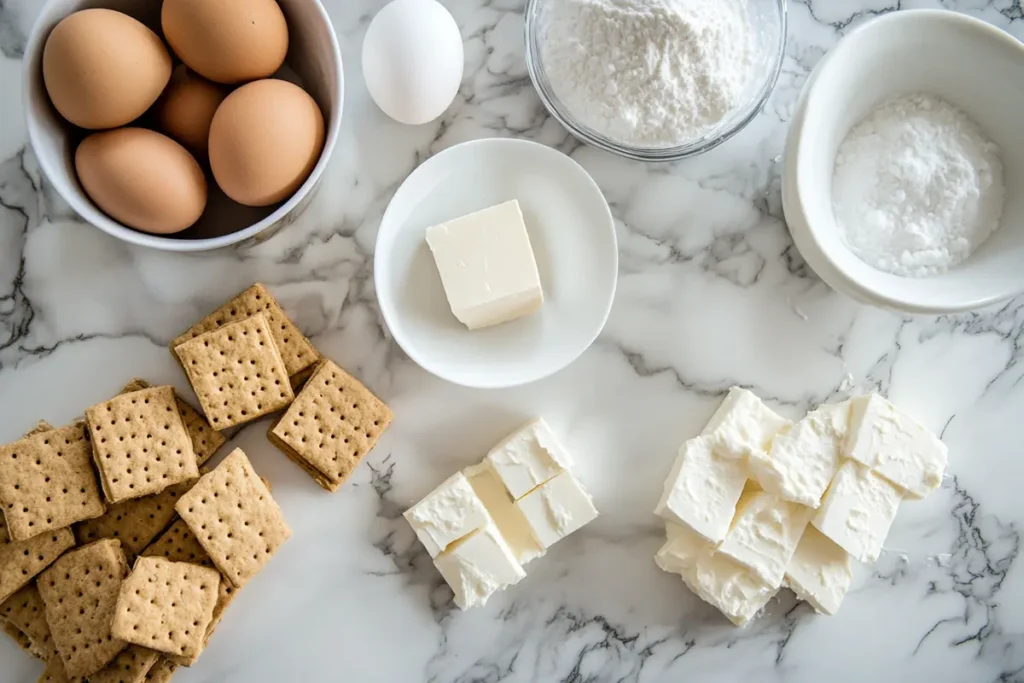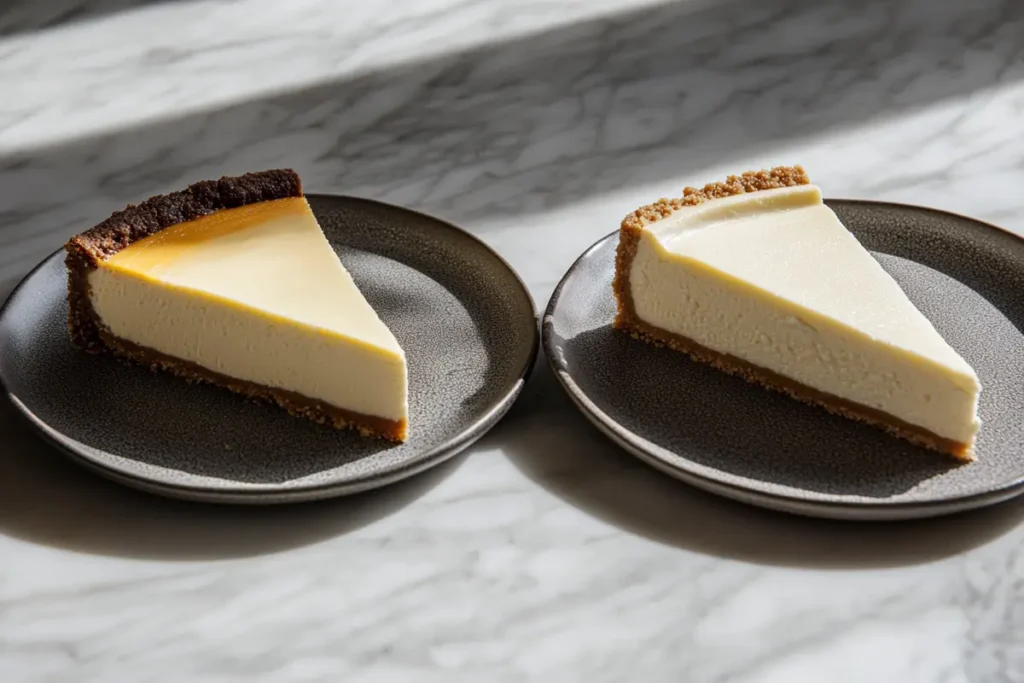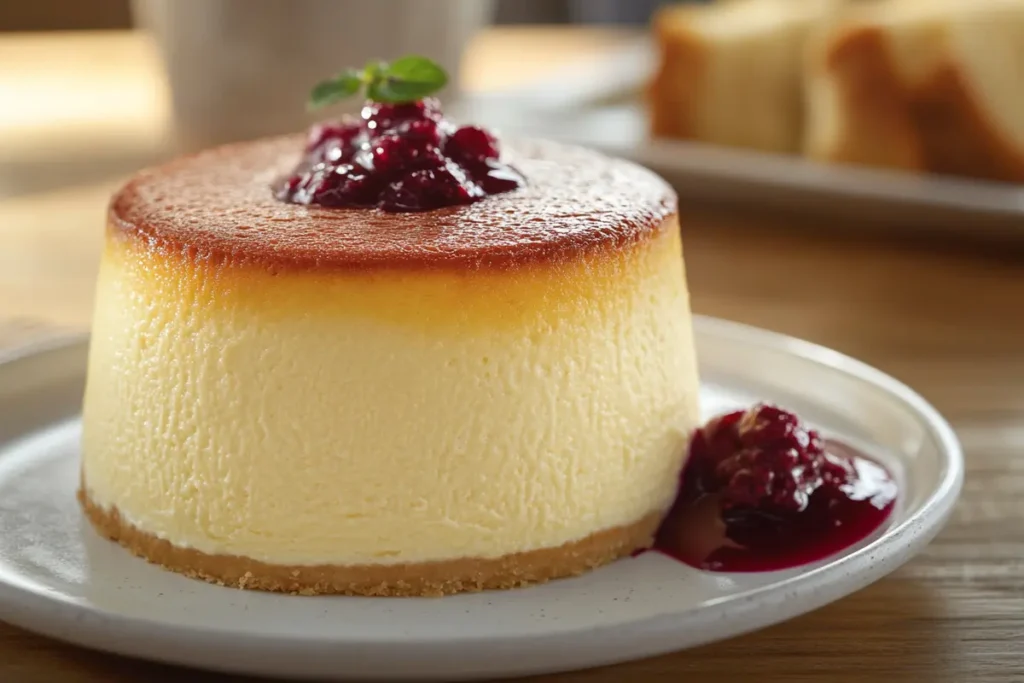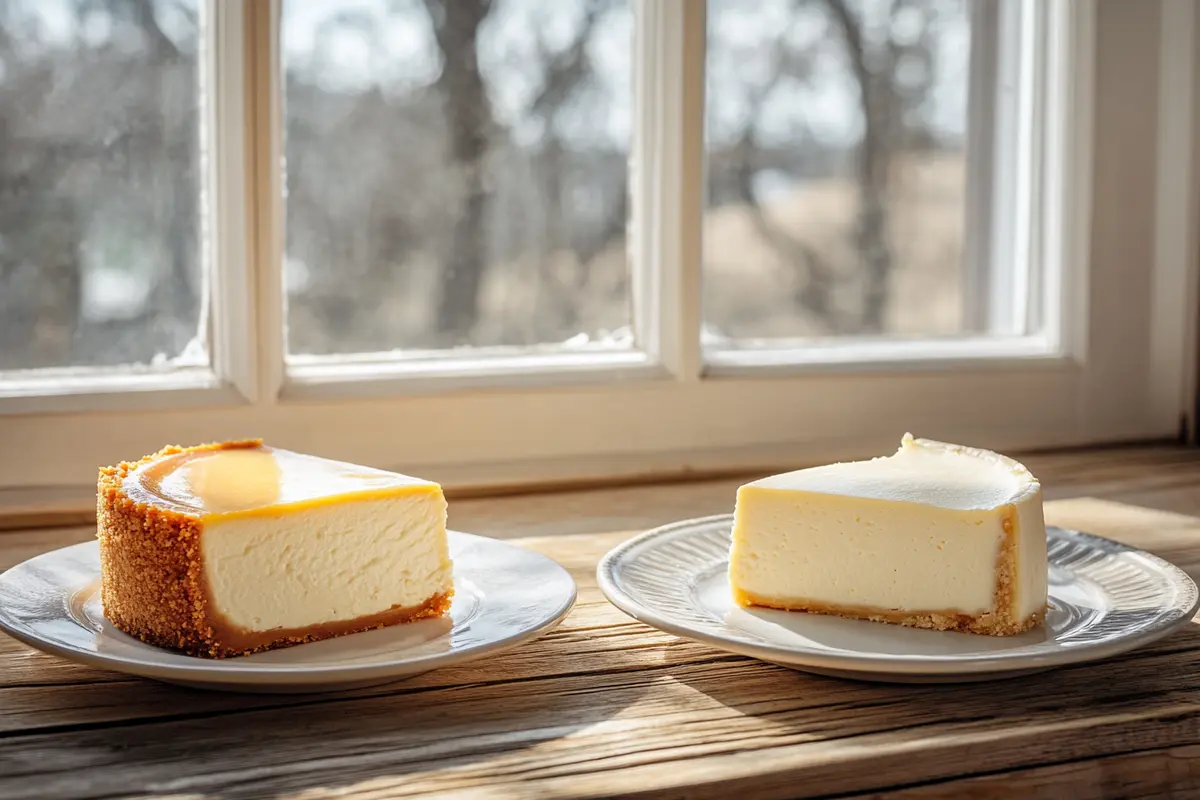What is the difference between American cheesecake and regular cheesecake? Many people wonder about the contrasting characteristics of these popular desserts. Both share a smooth, creamy base and a rich flavor. However, American cheesecake often presents unique features that set it apart. In addition, chefs worldwide experiment with ingredients, creating new variations that differ from what many consider “regular” cheesecake.
Understanding The Basics Of Cheesecake
Before diving deeper, it helps to define “regular” cheesecake. Often, “regular” cheesecake refers to a general style made outside the U.S. This can include classic European versions. For example, a German Käsekuchen uses quark, while Italian torta di ricotta uses creamy ricotta cheese. Each region has its own approach. However, American cheesecake remains a distinct category.
In addition, American cheesecakes are usually richer and sweeter. They often feature a dense, tall slice that feels substantial on the tongue. Meanwhile, non-American versions may feel lighter, fluffier, or more crumbly. Therefore, the difference starts with the base cheese but extends to every element of the dessert.
Key Ingredients That Set American Cheesecake Apart
To understand what is the difference between American cheesecake and regular cheesecake? you must first look at ingredients. American cheesecake leans heavily on cream cheese. This gives it a signature mouthfeel that feels luxurious. Meanwhile, regular cheesecakes vary in their dairy choices:
- Cream Cheese (American): A soft, spreadable cheese with high fat content. It delivers richness and a stable structure.
- Ricotta (Italian): Lighter and grainier. It creates a more delicate and less dense texture.
- Quark (German): Tangy, fresh cheese that results in a lighter, fluffier consistency.
- Mascarpone (Some European Variations): Adds richness but can result in a silkier yet sometimes heavier texture.
In addition, American cheesecakes usually include eggs, sugar, and sour cream to achieve a balanced sweetness and creaminess. Meanwhile, regular cheesecakes might rely on different thickeners, starches, or flavorings. Therefore, the ingredient choices directly shape the final dessert’s mouthfeel and taste.

Differences In Crust And Base Layers
What is the difference between American cheesecake and regular cheesecake? Another major factor lies in the crust. American cheesecakes commonly rest on a thick graham cracker crust. This crust offers a sweet, crunchy contrast to the creamy filling. Moreover, its toasted flavor pairs perfectly with the richness of cream cheese.
In other regions, the crust can differ drastically. For example, a traditional European cheesecake might use a simple shortcrust pastry or even skip a crust altogether. Moreover, some prefer a sponge cake base or a layer of biscuits rather than graham crackers. Therefore, these crust variations influence the final taste and texture. In addition, the choice of crust can highlight or subdue the sweetness, making the dessert feel balanced or heavy.

Baking Techniques And Styles
To delve deeper into what is the difference between American cheesecake and regular cheesecake?, consider baking methods. American cheesecakes often use a water bath (bain-marie) technique to achieve a smooth, crack-free surface. This method ensures even heat distribution. In addition, bakers often let the cheesecake cool slowly in the oven to prevent cracks.
However, not all cheesecakes follow this pattern. Many European versions bake at lower temperatures or skip the water bath, leading to a slightly different texture. Some variants, like Japanese cotton cheesecake, prioritize a fluffy, airy texture through careful whipping and steaming. Therefore, the American approach leans toward a dense, creamy consistency, while others might favor something lighter and more delicate.
Sweetness And Flavor Profiles
What is the difference between American cheesecake and regular cheesecake? Another defining difference is sweetness. American cheesecakes tend to be sweeter, appealing to those who love rich desserts. Meanwhile, many European or Asian cheesecakes have more subtle sweetness, allowing the dairy flavor to shine. In addition, regular cheesecakes might incorporate citrus zest or tangy fruit purees, adding complexity to each bite.
Texture Variations And Mouthfeel
Texture is central to the cheesecake experience. American cheesecake is known for its velvety density. Each forkful feels substantial, coating your tongue in rich creaminess. Moreover, the use of cream cheese and a careful baking process ensures a luxurious texture.
Regular cheesecakes often differ. A European cheesecake might feel lighter, fluffier, or even crumbly if using a cheese like quark. An Italian cheesecake may have a slightly grainy feel from ricotta. However, this difference does not make one superior to the other. Instead, it highlights the diverse ways to enjoy this dessert. In addition, some cheesecake enthusiasts prefer a lighter bite, while others crave the heft of a classic American slice.
Regional Influences On Cheesecake Styles
What is the difference between American cheesecake and regular cheesecake? Culture and tradition play a key role. In the U.S., cream cheese became widely available and affordable in the early 20th century. This sparked the rise of the American cheesecake style. Moreover, the iconic New York cheesecake evolved from this foundation, becoming a culinary symbol of the city.
In Europe, local cheeses have influenced regional recipes. Quark-based German cheesecake or ricotta-based Italian cheesecake reflect the cheeses prevalent in those areas. In Asia, lighter, fluffier versions have emerged, blending Western techniques with local taste preferences. Therefore, geography and history shape the various interpretations of “regular” cheesecake around the world.
The Iconic New York Cheesecake
When discussing what is the difference between American cheesecake and regular cheesecake?, the New York cheesecake deserves special attention. This famous variant uses more cream cheese, often incorporating heavy cream or sour cream. The result is a rich, dense texture that many consider the pinnacle of American cheesecake.
In addition, New York cheesecake typically has a graham cracker crust and a subtle, tangy flavor. Its simplicity allows the cream cheese flavor to stand out. Therefore, many consider it the gold standard by which other cheesecakes are measured.

Comparing Baking Times And Techniques
The baking process itself differs between American and regular cheesecakes. American cheesecakes usually bake low and slow, often around 325°F (163°C) for about an hour. Then, bakers may leave the cheesecake in the oven with the door cracked open to cool. This careful approach prevents sudden temperature changes and keeps the top from cracking.
Conversely, some regular cheesecakes might bake at slightly higher temperatures or rely on shorter baking times. Others might not require a water bath, resulting in a slightly different texture. In addition, some recipes call for partial baking or chilling instead of a full bake. Therefore, these subtle differences influence the final product’s taste and mouthfeel.
Common Toppings And Garnishes
Another way to see what is the difference between American cheesecake and regular cheesecake? is by examining typical toppings. American cheesecakes often appear plain or topped with fresh fruit, fruit compotes, or chocolate ganache. These additions enhance the richness and sweet profile. Moreover, whipped cream is a common companion.
Regular cheesecakes from Europe might feature more modest garnishes. They might be dusted with powdered sugar or served with a simple berry sauce. In some cases, a drizzle of honey or a scattering of nuts highlights the cheese’s natural flavor. Therefore, the style and culture behind each recipe guide the choice of toppings.
Presentation And Serving Suggestions
Presentation also varies between American and regular cheesecakes. American cheesecakes often come as tall, generous slices. They may be served chilled, allowing the filling to set firmly. Therefore, a classic presentation might involve a wedge with a few fresh berries on top.
Regular cheesecakes might appear in thinner slices or smaller portions. Some European cheesecakes are lighter and can be served alongside coffee or tea as a delicate treat. In addition, the texture might allow for easier pairing with various condiments, like a thin fruit sauce or a dollop of crème fraîche.
Nutritional Differences
What is the difference between American cheesecake and regular cheesecake? In nutritional terms, American cheesecake might be richer in fat and sugar due to the cream cheese and sweet crust. Regular cheesecakes, depending on the cheese used, may have a lighter nutritional profile. For example, ricotta or quark can be lower in fat. However, this is not always the case, as recipes can vary widely.
In addition, serving size plays a role. A single slice of American cheesecake can be very rich, possibly best enjoyed in moderation. A lighter European cheesecake slice may feel less indulgent but still satisfies a sweet craving. Therefore, personal preference and dietary considerations influence which style someone might choose.
Cultural Perceptions And Preferences
Many factors shape how people perceive cheesecakes. In the U.S., cheesecake often represents comfort, indulgence, and a special treat. On the other hand, in other parts of the world, cheesecake might be viewed as an elegant dessert or a traditional family recipe. Therefore, these cultural perceptions influence how bakers and diners define “regular” cheesecake.
In addition, the sweetness level that Americans prefer can differ from other cultures. Some regions favor less sugar and more natural dairy flavors. Consequently, these differences create a broad spectrum of cheesecakes, each appealing to certain tastes and traditions.
Exploring Cheesecake Variations Worldwide
Cheesecake is not limited to American and European styles. For example, Japanese cheesecake is known for its airy, soufflé-like texture. Meanwhile, Latin American versions might use local dairy products or incorporate tropical fruits. In addition, some regions experiment with matcha, spices, or nut-based crusts. Therefore, “regular” cheesecake becomes an umbrella term for many styles.
These variations help us see what is the difference between American cheesecake and regular cheesecake? as part of a global conversation. Each region adapts the dessert, reflecting local ingredients and preferences. As a result, cheesecake becomes a universal treat, constantly evolving.
Serving Temperature Considerations
What is the difference between American cheesecake and regular cheesecake? Serving temperature affects texture and flavor. American cheesecakes are best served chilled. The cool temperature helps maintain their density and smoothness. However, letting them sit at room temperature for a few minutes can enhance creaminess.
Regular cheesecakes may follow similar guidelines, but some might benefit from a slightly warmer serving temperature. For example, a cheesecake with ricotta might release more aroma and flavor if not too cold. Therefore, personal preference and the particular style of cheesecake guide the optimal serving temperature.
Pairing Cheesecakes With Beverages
Pairing cheesecake with beverages can highlight differences. American cheesecake, with its rich sweetness, pairs well with strong coffee or espresso. The bitterness of coffee cuts through the richness, balancing each bite. In addition, black tea or a dessert wine can also complement the creamy texture.
Regular cheesecakes, being lighter or tangier, might pair well with a delicate tea, sparkling wine, or even a citrus-infused water. Therefore, these pairing options reflect the cheesecake’s nature. A denser, sweeter cheesecake calls for a robust companion, while a lighter one pairs nicely with something subtle.
The Role Of Tradition And Memory
Part of understanding what is the difference between American cheesecake and regular cheesecake? involves acknowledging tradition. Many people have cherished childhood memories tied to a specific style of cheesecake. Perhaps they remember their grandmother’s recipe passed down through generations. In such cases, the “regular” cheesecake might be the one they grew up with, regardless of origin.
In addition, these traditions shape personal taste. Someone raised on New York cheesecake may always favor its density. Another person introduced to a light ricotta cheesecake might prefer a fluffier texture. Therefore, personal history and nostalgia influence how one perceives differences.
Conclusion: Embracing Cheesecake Diversity
What is the difference between American cheesecake and regular cheesecake? The answer involves many factors—ingredients, textures, baking methods, sweetness, cultural influences, and personal preference. American cheesecake typically uses cream cheese, resulting in a dense, rich dessert with a graham cracker crust. Regular cheesecakes, often from Europe, may feature lighter cheeses like ricotta or quark, producing a fluffier or tangier treat.
However, neither style is superior. Instead, these differences highlight the beauty of culinary diversity. By exploring various cheesecakes, we learn that subtle changes in cheese, crust, and technique can produce dramatically different results. Therefore, the best way to understand these differences is to taste both and appreciate what each version brings to the table.
Frequently Asked Questions
Why is American cheesecake different?
American cheesecake is different because it uses cream cheese as its main ingredient, resulting in a denser, richer texture. In addition, it often features a graham cracker crust, making it sweeter and more indulgent compared to versions that rely on lighter cheeses.
What are the two types of cheesecake?
The two types of cheesecake often discussed are the American-style cheesecake and the European-style cheesecake. American cheesecake uses cream cheese and tends to be dense and sweet. European cheesecakes vary by region, often using lighter cheeses like ricotta or quark, resulting in a fluffier, tangier dessert.
What’s the difference between a New York cheesecake and a regular cheesecake?
A New York cheesecake, a classic American style, is creamier, denser, and richer due to its high cream cheese content and the addition of sour cream or heavy cream. Regular cheesecake can refer to various styles worldwide, many of which are lighter, fluffier, or less sweet, depending on the cheese and technique used.
What is the difference between American cheesecake and Italian cheesecake?
American cheesecake uses cream cheese and a graham cracker crust, producing a dense and rich texture. Italian cheesecake, made with ricotta, is lighter and less sweet, often featuring citrus zest or honey for subtle flavor differences. The result is a less heavy, more delicate dessert.

